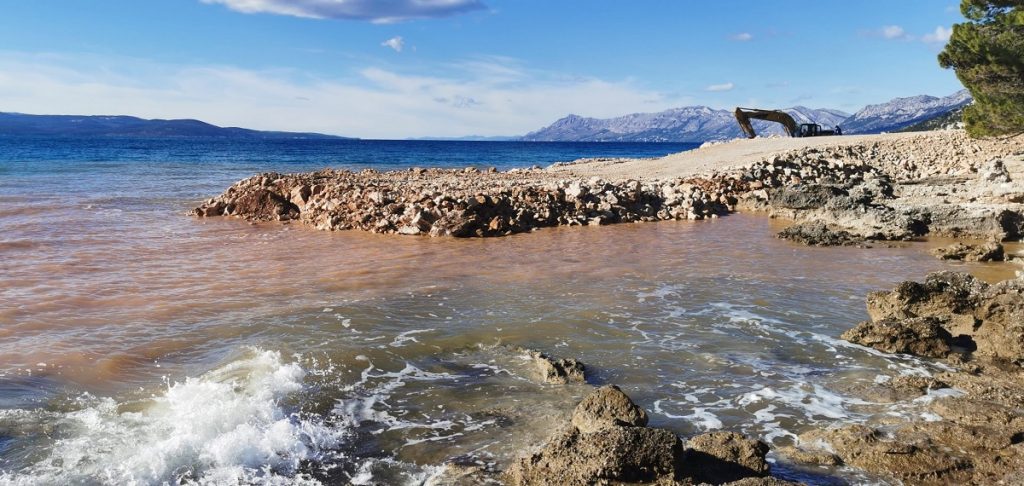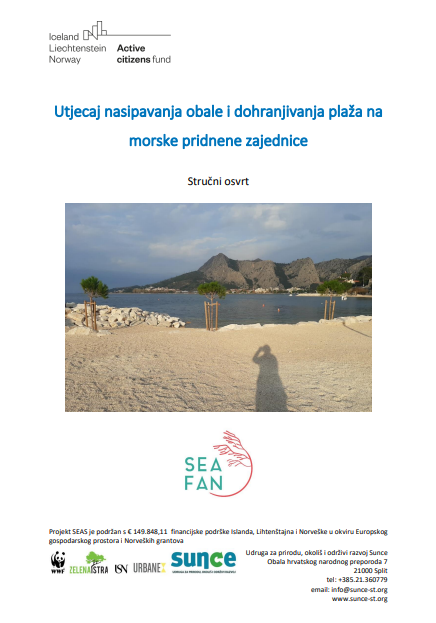
Everywhere in the world, the sea coast is the most attractive area for life and tourism, but are we protecting this irreplaceable resource in Croatia? Logic tells us that we should, but what is happening on our coast points the opposite.

Every spring, excavators “prepare” the coast for the summer season. Scrapers are being used, trucks are throwing out soli and stones into the shallows, concrete is being mixed and every pebble is concreted. This is evidenced by the numerous complaints that we receive every day on the Green phone (072 – 123 – 456). Over the past five years, more than 350 reports of coastal devastation have been received.

Stop beach filling
Precisely for this reason, in May 2022, Sunce, Zelena Istra and WWF Adria launched an online campaign Stop beach filling, which aim is to make the public aware of the solutions advocated by civil society organizations to protect and ensure effective management of the marine environment. Also, the campaign wants to strengthen the public’s positive perception of the role of civil society environmental organizations in the adoption and creation of policies and acts related to the management of the marine environment, guided by the principles of environmental protection.

The average length of the coast of Croatian beaches is 370 m, which ranks them among the shortest beaches in the world (Carević, 2020). Therefore, coastal municipalities and cities are deciding to create an increasing number of new beaches and/or expand the capacity of existing ones, to meet the needs of the growing number of tourists, according to their assessment.
In the absence of financial resources for the implementation of a complete beach construction project, local self-government units usually decide on the seemingly cheaper practice of ad hoc beach filling. Without elements that would ensure stability and resistance to the wave’s influence, the beaches will “dance” for only one summer. At best, they last one summer season, and then the winter storms simply wash them away.
Ph.D. SIlvija Kipson research
– When we saw a truck that dropped a whole bunch of soil and stones into the sea, we assumed that there had been damage to the environment, but we didn’t know what exactly was happening under the sea and why it was wrong. As part of the project Preserving the Adriatic Sea Ecosystems by Active Participation of Citizens – SEAS, we ordered research about the impact of beach filling and replenishment on seabed communities under the guidance of expert Ph.D. SIlvija Kipson. Review work of Ph.D. Kipson gives us a window into the sea and shows us examples of how the use of inadequate material for beach filling makes various changes in the biogeochemistry of the environment, which thereby ceases to be a suitable habitat for the previous organisms – emphasizes Ivana Krstulović Baković, SEAS project manager at the Association Sunce.

– The math is simple, inadequate ad hoc beach filling can cause significant environmental and economic damage. The unsustainability of such interventions and the consequences of dumped materials on the environment are exactly what this campaign warns about – says Irena Burba, president of the association Zelena Istra.
Keeping in mind the constant aspiration of economic progress in tourism, in this year’s Policy Statement of the legal team of the Association Sunce we’ve put an example of the filling of the Poniente beach in Spain, where the local authorities, wishing to create touristic and local value, lost the same.
A big problem is also deficiency of inspection capacity, which leads failure in sanctionating illegal construction and permanent devastation of space. After illegal actions have already been made on the sea coast, a measure of return to the previous state is rarely ordered and that is also extremely problematic. Moreover, many illegal procedures are legalized after the filling has already been carried out.
– Last year, we received a complaint about the filling up of the coast and the sea on Krknjaši near Drvenik. Even though the municipal police took certain measures against the perpetrators, the dumped material was abandoned at the location until the sea washed it away. So, because of beach filling, the marine ecosystem at the location was also destroyed – explained Hajdi Biuk, The Association Sunce lawyer.
– We are witnessing that a lot of individuals, who did not obtain the necessary permits build on he coast, and if we are looking at the Coastal Plan of the Split-Dalmatia County, it is evident that even those who are entrusted with the care of the maritime domain are leaning towards cheaper and faster solutions that are unsustainable in the long term. Therefore, we ask ourselves, how long will self-willed concreting and beach filling continue, without lasting consequences? – Krstulović Baković added.
Development of the coast should be guided by the principles of environmental protection
The Association Sunce continuously warns that the development of the coast should be guided by the principles of environmental protection, primarly taking into account the precautionary principle. This means that every human activity in the environment must first be assessed as safe for the environment within the prescribed legal procedure and with the participation of expert bodies.


In 2020, the legal team of the Association Sunce warned about the wrong attitude of human towards the Adriatic beaches in a Policy Statement, where, among other things, we listed the regulations and legal steps that citizens can take if they notice the devastation of the coast.
Nevertheless, Sunce also witnesses some good examples from practice when the competent authorities used their powers in the inspection procedure for the purpose of environmental protection, in Seget Vranjic and Makarska.
Can we have economic growth and development while preserving the environment?
– Through the campaign, we are trying to make the public aware that coastal extension or seasonal replenishments do not look so problematic individually until we look at the bigger picture and add up the consequences that all these regular “improvements” of the coast leave on the environment in different locations throughout the Adriatic sea. The meadows of seagrass are often buried by filling, which leads to their death, especially the endangered Posidonia meadows. This destroys habitats important for the survival of several economically important, but also rare and endangered species – added Pinija Poljaković from WWF Adria.
– With the campaign, we want to convey that we need natural, healthy and unique. Because of this, we do not hinder the development of the economy, on the contrary, with our work we offer solutions that encourage economic growth and development while preserving the environment – concluded Krstulović Baković.
So what are the solutions?
Some of the possible steps of coastal management, which satisfies the needs of the local community while preserving the environment and financial profitability, are also offered by Dr. sc. Kipson in her research for the SEAS project:
1. create or modify/complement the legal regulations that would define the methods and ways of beach replenishment, including the necessary standards on the quality of beach material (Carević, 2020)
2. promote “good practice” related to the problem of beach erosion (highlighted, for example, in the Coastal Plan of the SDŽ)
3. advocate adequate supervision during the execution of works (e.g. method, quantity and quality of the filled material)
4. advocate alternative, more sustainable solutions, e.g.:
a. the concept of increasing the capacity of beaches, which considers measures that minimally affect the natural balance and includes the extension of the beach into the hinterland or the installation of “seasonal” sunbathing areas (potentially also made of artificial materials) that can be removed after the summer season (Carević, 2020);
b. nature-based solutions (see Morris et al., 2021), e.g. maintaining a good conservation status of seagrass plants that stabilize sediment with their roots while reducing wave energy with their leaves, thus preventing, or at least reducing, coastal erosion and acting as “natural guardians of the beach”.
We would change the comfort of sunbathing on a concrete plateau for a natural beach and the experience of diving into the sea full of life. And you?
Campaign: Stop beach filling was created as part of the project Preserving the Adriatic Sea Ecosystems by Active Participation of CitizenS – SEAS.
The SEAS project is implemented with the financial support of Iceland, Liechtenstein and Norway within the framework of EEA grants, and our project partners are WWF Adria, Udruga Zelena Istra, Urbanex d.o.o. and the University of South-Eastern Norway (USN).
